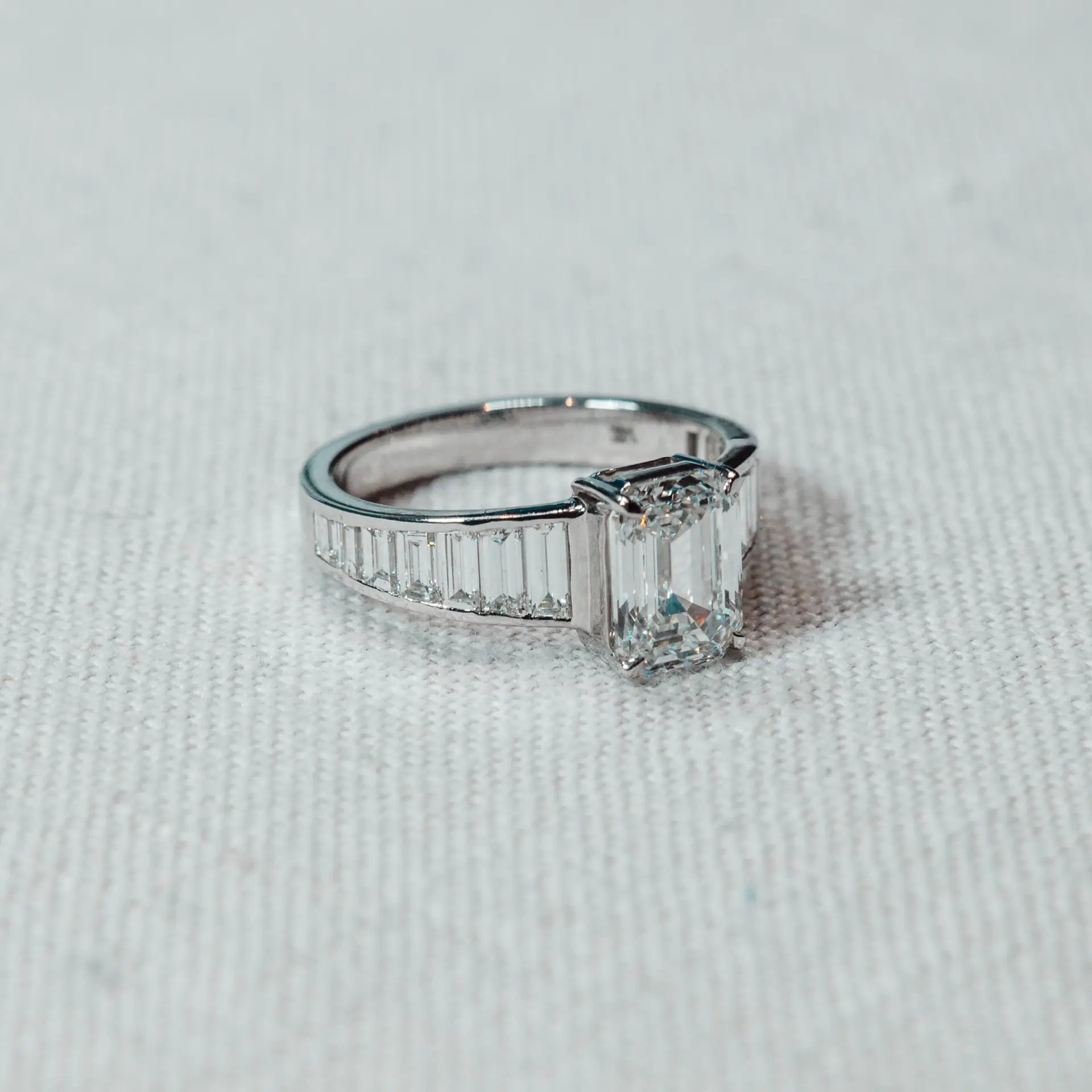 #
#
Gabrielle’s Ideals for Emerald Diamonds #
(Table: 61–68% (64–65%), Depth: 60–69% (67–68.4%), Pavilion Depth: 47–53 (49–51%), Pavilion Angle: 40.5–43° (40.6°–42.5°), Crown Angle: 30–40° (35°–36.6°), Crown Height: 12–15%, Girdle: 2.5–4.5%)
The emerald cut diamond is one of the most sophisticated and elegant diamond shapes, known for its distinctive step-cut faceting and elongated form. Unlike brilliant cuts, which maximize sparkle, the emerald cut creates a hall-of-mirrors effect, emphasizing clarity, depth, and subtle flashes of light rather than intense fire and brilliance.
First developed during the Art Deco period of the 1920s, the emerald cut quickly became synonymous with glamour and refinement. It was favored by celebrities and royalty for its clean lines and understated beauty. Its long, linear facets and open table highlight the diamond’s natural clarity, making proportion, symmetry, and clarity even more important in selection.
#
1. What Is an Emerald Lab Diamond? #
Unlike round or brilliant cuts, emerald diamonds are step-cut, meaning they have long, parallel facets rather than triangular ones. This results in a unique optical effect where light moves through the diamond in broad, sleek flashes rather than a scattered sparkle.
The emerald cut also has trimmed corners, giving it a sleek, architectural shape that makes it a perfect choice for those who love clean, structured aesthetics. The length-to-width ratio of an emerald cut varies based on personal preference, but the most balanced and elegant range is typically 1.30–1.45.
Why Choose an Emerald Lab Diamond? #
-
Timeless Elegance:
An emerald cut’s clean, geometric lines exude a classic, understated charm that never goes out of style. -
Emphasis on Clarity:
The open facet structure of emerald cuts highlights the diamond’s clarity and color, making high-quality stones particularly desirable. -
Subtle Brilliance:
Unlike brilliant cuts, emeralds produce a “hall of mirrors” effect, offering a refined light performance that is both graceful and sophisticated. -
Versatile Appeal:
The emerald cut’s elongated, rectangular shape suits various jewelry styles, from vintage-inspired to contemporary designs.
Potential Downsides of an Emerald Diamond #
-
Windowing: Due to the open facet structure, emerald cuts are prone to windowing—an area of darkness in the center if light escapes instead of reflecting back, or tilt-windowing, which causes flatness in the stone due to large openings when the stone is tilted side to side.
-
Windowing is the most challenging aspect of buying a diamond online. You need to account for windowing, and the only way to truly determine that, is if the person you are working with, or retailer you are buying from, can show you the stone side to side against a hand or colored paper. Here is an example: I’ve found a lot of people are caught up on minimal windowing which is inevitable with a step cut, so we should be concerned with something like this – https://imgur.com/a/4B6yohp
-
But NOT something like this (this IS what we want!) – https://imgur.com/a/w4NvsfJ
-
-
-
Clarity Sensitivity: Inclusions are more visible in emerald cuts, so higher clarity is generally necessary to achieve the best visual appeal. A VS1 should be the lowest that you go, and always ensure that you check a magnified loupe video.
-
Lower Scintillation: Compared to brilliant cuts, emeralds offer less sparkle, which may be a drawback for those seeking maximum fire and scintillation.
-
Shape Perception: An emerald is a deeper cut than a brilliant or hybrid cut, so unless it is a truly exceptional cut, it is highly likely that it will appear smaller than its carat weight. Aim for approximately 0.5 carats above the carat weight you want it to appear as, and pay close attention to length mm x width mm measurements.
-
Not Ideal for Small Carat Weights: Emerald cuts under 0.50ct may lack visual impact due to the large open table, making them better suited for larger stones.
 #
#
2. The 4Cs for an Emerald Lab Diamond #
While the 4Cs—Cut, Color, Clarity, and Carat—are essential for every diamond, the cut is particularly crucial for emeralds, as it directly influences the mirror-like effect and overall elegance of the stone.
Cut – The Heart of Emerald Brilliance
Getting the cut right means dialing in these key proportions:
-
Table Percentage (IGI’s ideals: 61–68% | Gabrielle’s Ideals: 64–65%):
The table is the largest facet, and in emerald cuts, it should be optimized to showcase the stone’s clarity and color. -
Depth Percentage (IGI’s ideals: 60–69% | Gabrielle’s Ideals: 67–68.4%):
Depth determines the overall height of the diamond relative to its width. An ideal depth ensures that light bounces effectively, minimizing windowing. -
Pavilion Depth (IGI’s ideals: 47–53% | Gabrielle’s Ideals: 49–51%):
The pavilion is where internal reflections occur. Proper pavilion depth is key to returning light and enhancing the stone’s luster. -
Pavilion Angle (IGI’s ideals: 40.5–43° | Gabrielle’s Ideals: 40.6°–42.5°):
This angle guides the light through the stone, contributing to the “hall of mirrors” effect that defines an emerald’s elegance. -
Crown Angle (IGI’s ideals: 30–40° | Gabrielle’s Ideals: 35°–36.6°):
The crown angle disperses light across the stone’s surface, balancing overall brightness with subtle fire. -
Crown Height (12–15%) & Girdle (2.5–4.5%):
These parameters contribute to both the diamond’s structural integrity and its visual appeal, ensuring durability alongside refined performance.
Pro Tip: In emerald cuts, precision in the cut is vital. Even minor deviations can lead to noticeable windowing or diminished mirror effects. The focus is less on scintillation and more on clarity and the graceful reflection of light.
Color – Enhancing the Icy Sparkle
Emerald diamonds are crafted to reveal a bright, white appearance. Choosing the right color grade is essential to maximize their refined brilliance:
-
D–F (Colorless): Offers a pristine, icy-white look that complements the stone’s elegant step cut.
-
G–H (Near Colorless): Provides an excellent balance between value and the sought-after white radiance.
-
I–J: May add a touch of warmth—ideal if the diamond is set in yellow or rose gold, which can harmonize with the stone’s subtle luster.
Pro Tip: For emerald cuts, a higher color grade is particularly beneficial, as the open facets reveal any tint more readily than in brilliant cuts. Don’t go lower than G (unless you’re specifically looking for a warmer stone!)
Clarity – Focus on Structural Integrity
Since the step cut of an emerald exposes the stone’s internal characteristics, clarity is paramount:
-
VVS1–VVS2: Nearly flawless stones deliver exceptional beauty but come at a premium. For an emerald cut, it’s worth it to aim higher on clarity.
-
VS1–VS2: Often the ideal range, offering excellent clarity with minimal inclusions visible to the naked eye. However, for an emerald, we don’t recommend going lower than a VS1.
-
SI1–SI2: May be acceptable if inclusions are minor and do not disrupt the mirror effect.
-
F–IF: Flawless diamonds exist but are generally unnecessary for most buyers, especially given the emphasis on clarity in emerald cuts.
Pro Tip: Due to the open facet design, opting for VVS2/VS1 clarity is typically recommended to ensure maximum visual appeal.
Carat – More Size for Your Budget
Lab diamonds allow you to choose larger stones without sacrificing quality. However, a well-cut diamond with ideal proportions in emerald cuts will always exhibit superior elegance compared to a larger stone with compromised cut quality.
Pro Tip: Prioritize cut quality over carat size—a perfectly proportioned 1.50 ct emerald can appear more brighter and face up larger than a poorly cut 1.75 ct stone.
3. Additional Considerations #
Symmetry & Polish
-
Symmetry: Excellent symmetry ensures the step-cut facets are evenly spaced, preventing lopsided reflections.
-
Polish: Excellent or very good polish ensures that the well-defined facets enhance the hall-of-mirrors effect.
Fluorescence
-
None or Faint fluorescence is best, as strong fluorescence can sometimes create a hazy effect.
Certification
-
Always buy IGI- or GIA-certified diamonds to ensure accurate grading.
Setting Considerations
-
Metal Choice: White gold or platinum enhances the icy brightness of an emerald diamond, while yellow or rose gold can add a touch of warmth that complements its elegant design.
-
Setting Style: Prong settings are ideal for maximizing light exposure, ensuring that every facet contributes to the stone’s understated yet captivating brilliance.
#
Final Thoughts #
A well-cut emerald diamond is all about proportion, symmetry, and clarity. While it may not have the intense brilliance of a round or oval, its sophisticated step-cut faceting creates an elegant, mirror-like play of light.
By following Gabrielle’s Ideals, you can confidently select an emerald cut diamond that is clean, balanced, and beautifully refined.
Happy diamond hunting—may your emerald cut diamond reflect your timeless style!


